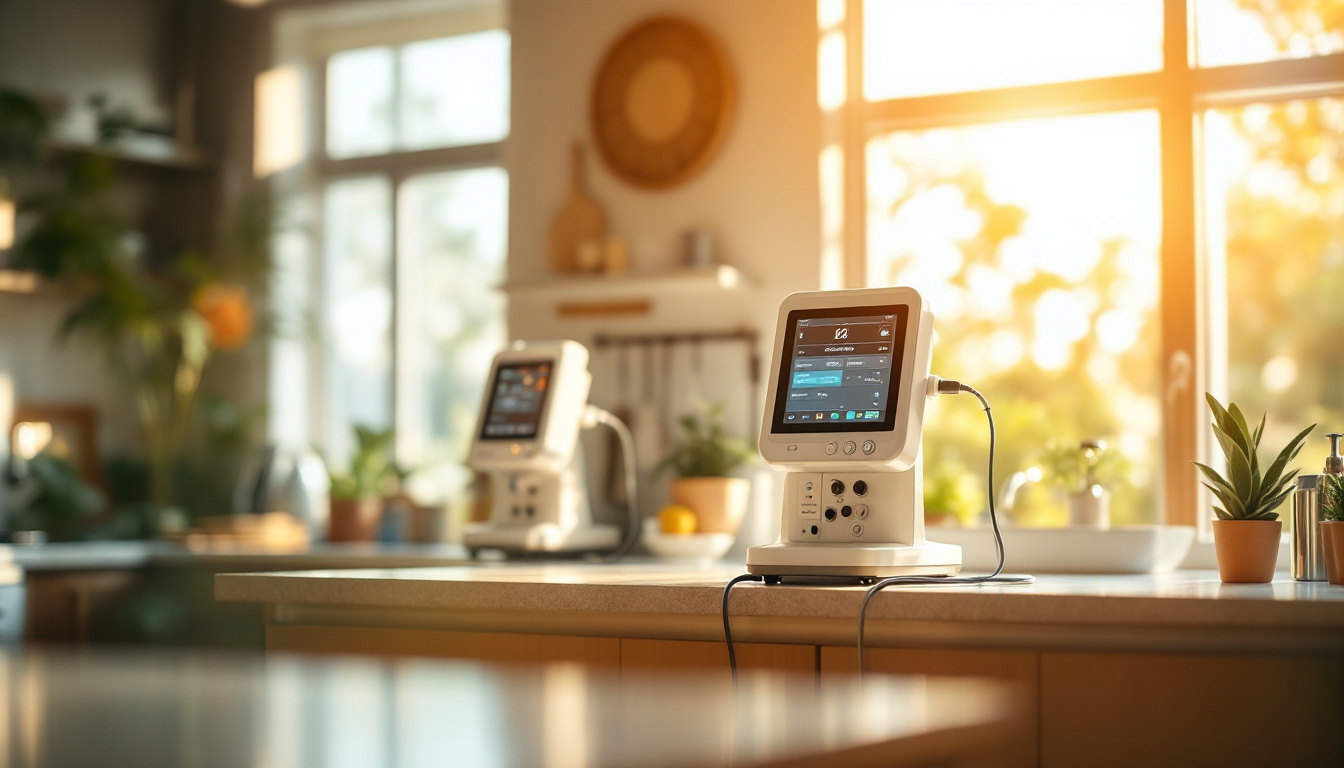What is sterile compounding for dialysis support?

Understanding Sterile Compounding for Dialysis
Sterile compounding plays a vital role in dialysis support, ensuring that patients receive medications prepared with the highest standards of safety and efficacy. Through sterile compounding, healthcare professionals create customized medications that are vital for patients with vulnerable health conditions such as those undergoing dialysis. This narrative explores the significant facets of sterile compounding in dialysis, addressing key processes, guidelines, and its importance in patient care.
The Basics of Sterile Compounding

What does sterile compounding mean?
Sterile compounding refers to the preparation of customized medications in a controlled, contamination-free environment to ensure patient safety and medication efficacy. This process is crucial for creating medications such as intravenous injections, inhalation solutions, and eyedrops, all of which require strict aseptic techniques during their preparation.
Compounded sterile preparations (CSPs) must be produced under conditions that prevent contamination, as even tiny microbial presence can pose serious risks to patients, especially those undergoing treatments like dialysis. The professionals involved in sterile compounding—which include specially trained pharmacists and pharmacy technicians—must adhere to rigorous standards established by regulatory bodies such as the United States Pharmacopeia (USP) and the ASHP guidelines, specifically USP Chapter 797.
Why is it important in healthcare?
The significance of sterile compounding in healthcare cannot be overstated. It caters to patients with specific needs, particularly those who may not find suitable treatments in commercially available medications due to allergies or different clinical requirements. Given that about 95% of hospitals have policies for sterile preparation compounding, the focus on safety in this domain reflects a strong procedural commitment across healthcare settings.
Moreover, as the healthcare landscape evolves, the demand for pharmacy technicians trained in sterile compounding is projected to rise by 7% by 2033. This growth illustrates the increasing emphasis on patient safety and precision in pharmaceuticals. Compounding pharmacies, which provide these specialized services, are essential in ensuring that patients receive quality medications tailored to their unique conditions.
In summary, the sterile compounding process is foundational to providing safe, effective, and personalized patient care in various medical scenarios.
The Critical Role of Sterile Compounding in Dialysis

Importance of sterility in dialysis
Sterile compounding plays a vital role in ensuring the safety and efficacy of medications used in dialysis. Dialysis patients are often immunocompromised, making them particularly vulnerable to infections. Therefore, compounded sterile preparations (CSPs) must be meticulously prepared to prevent any microbial contamination.
Strict adherence to guidelines such as the USP <797> is essential. This includes employing aseptic techniques in controlled environments, which help maintain sterility throughout the compounding process. The risks associated with non-sterile preparations can have dire consequences, including severe infections that complicate the patients' conditions.
Compounded medications for dialysis patients
Patients undergoing dialysis may have unique medication needs due to their conditions. Compounding pharmacists create tailored solutions and injectables that are not available commercially. For instance, erythropoietin-stimulating agents, which combat anemia in dialysis patients, must be compounded sterile to ensure their safety and effectiveness.
Moreover, the necessity for customized medications arises in cases where patients exhibit sensitivities or allergies to standard treatments. This can include sterile compounding of autologous serum eye drops for patients suffering from ocular conditions related to their treatment, reflecting the need to address specific patient conditions proactively.
Examples of essential scenarios
Sterile compounding is essential in various scenarios concerning dialysis patients:
| Scenario | Description | Importance |
|---|---|---|
| Intravenous solutions | Patients receive IV solutions for hydration and nutrient replenishment. | Must be sterile to avoid introducing harmful pathogens into the bloodstream. |
| Specialized medications | Tailored medications such as erythropoietin-stimulating agents for anemia management are prepared for dialysis patients. | Ensuring these drugs are compounded under sterile conditions is crucial for their safe use. |
| Ocular treatments | Autologous serum drops may be prepared for patients with eye issues related to dialysis. | These specialized treatments rely on strict sterility to prevent infections that could worsen eye conditions. |
Maintaining sterility during the compounding of these preparations is paramount, addressing the heightened risks that dialysis patients face. Thus, understanding the critical role of sterile compounding in this context emphasizes both the careful preparation involved and the potential consequences of lapses in protocol.
Compounding Techniques and Sterility Assurance
Aseptic techniques for sterile compounding
Aseptic techniques are fundamental in preparing compounded sterile preparations (CSPs) to ensure that these vital medications are free from contamination. This approach involves a meticulous sterile process wherein compounds are created in a controlled setting, limiting exposure to pathogens. Personnel engaged in sterile compounding, including pharmacists and technicians, must adhere to strict methods that include proper hand hygiene, the use of personal protective equipment, and routine environmental disinfection.
Aseptic manipulations must be conducted in designated clean areas, specifically designed to maintain sterility. Following guidelines set forth by organizations like the ASHP and complying with USP Chapter 797, staff members must implement rigorous safety practices to mitigate the risk of contamination, especially for vulnerable patients, such as those undergoing dialysis.
Controlled environments
To ensure the sterility of CSPs, compounding pharmacies must operate in controlled environments, typically classified as ISO Class 7 or ISO Class 5. These classifications regulate the level of airborne particulate contamination that can be present, ensuring a safe workspace for the preparation of sterile medications.
Environmental controls encompass ventilation systems that constantly filter and circulate air, reducing the introduction of contaminants. Regular monitoring and validation tests confirm the effectiveness of these systems, providing an added layer of assurance for patient safety.
Compounding practices must also prioritize quality assurance, reflecting the commitment to both compliance with regulatory standards and the well-being of patients relying on these custom formulations for their healthcare needs.
| Topic | Description | Importance |
|---|---|---|
| Aseptic techniques | Practices to prevent contamination in preparations | Ensures safety of CSPs |
| Controlled environments | ISO certified spaces for compounding | Maintains sterility during compounding |
Guidelines and Standards for Sterile Compounding

What standards and regulations govern sterile compounding practices, such as USP 797?
Sterile compounding practices are primarily governed by the United States Pharmacopeia (USP) General Chapter <797>. This chapter is crucial for enhancing patient safety and minimizing risks associated with contamination and incorrect dosing. Originally effective on January 1, 2004, the guidelines have been updated, with new protocols taking effect on November 1, 2023.
Key updates in the revised <797> include:
- Risk Categories: CSPs are categorized based on the risk of microbial contamination, which affects their handling and procedural requirements.
- Immediate Use Rule: The time allowed for certain preparations has been extended from 1 hour to 4 hours, facilitating the use of fresh compounding practices in various settings.
- Training Protocols: There’s a stronger emphasis on competency in aseptic practices for all personnel involved in compounding, underscoring the necessity of continuous training and evaluation.
Compliance with these standards is essential for ensuring the safety and efficacy of compounded sterile medications, particularly for vulnerable populations, including those on dialysis.
What are the ASHP guidelines on compounding sterile preparations?
The ASHP (American Society of Health-System Pharmacists) guidelines on compounding sterile preparations (CSPs) focus on the correct identity, purity, strength, and sterility of compounded products. They align closely with USP chapter <797>, ensuring a comprehensive approach to patient safety. These guidelines dictate:
- Risk Categorization: CSPs are classified based on their risk of microbial contamination, which informs their expiration and handling protocols.
- Environmental Monitoring: Continuous monitoring of the compounding environment is emphasized to maintain sterility and minimize contamination risks.
- Personnel Management: Strict requirements for training, competency assessments, and adherence to aseptic techniques for compounding staff are highlighted.
ASHP also offers various resources, including training programs and documentation templates. These tools assist in aligning pharmacy practices with the latest standards to ensure safety and compliance.
Regulatory standards for sterile compounding practices
Regulatory standards for sterile compounding practices are critical for maintaining quality and safety. These standards, which include the NAPRA Model Standards for Compounding Non-Hazardous and Hazardous Sterile Preparations, stress:
- Quality Assurance: Regular assessments of compounding procedures and environmental standards must be implemented.
- Risk Management: Initial priority is on risk assessment, followed by the development of comprehensive quality assurance programs.
- Compliance Reporting: Pharmacies engaging in sterile compounding must report their practices to local regulatory bodies to ensure adherence to established safety protocols.
These regulatory frameworks work together to foster a safer environment for compounded sterile preparations, ultimately benefiting patient care.
The Compounding Environment and Safety Measures
Clean Room Standards
The preparation of compounded sterile preparations (CSPs) must occur in environments that meet stringent clean room standards. These include compliance with ISO Class 7 and ISO Class 5 environments, designed to maintain a sterile environment and minimize contamination risks. In clean rooms, the airflow, temperature, humidity, and particulate limits are meticulously controlled. Adhering to these regulations is vital for ensuring that medications, particularly those used in vulnerable populations such as dialysis patients, are safe and effective.
Environmental Controls
Effective environmental controls are a cornerstone of sterile compounding practices. Pharmacy personnel are responsible for maintaining a clean workspace by conducting regular cleaning and disinfection processes. The guidance from organizations like ASHP reinforces the requirement that all compounding must follow stringent aseptic techniques. This includes regular monitoring of the environment to ensure compliance with established standards.
To further safeguard patient health, pharmacies must implement quality assurance programs that encompass risk assessments and routine inspections of compounding areas. These programs help identify potential risks and improve compliance with model standards. Through ongoing training and competency evaluations, pharmacists and technicians are equipped to adhere to the highest safety protocols, ensuring that compounded sterile preparations are both effective and without contamination risks.
| Aspect | Standard | Importance |
|---|---|---|
| Clean Room Class | ISO Class 7 and Class 5 | Ensures low particulate and microbial contamination |
| Monitoring Devices | Environmental Monitoring | Maintains quality and safety in compounding process |
| Training Protocols | Continuous Education | Reduces risk of errors during preparation |
Role of Pharmacists and Technicians in Sterile Compounding

Training and Certification
Training and certification for pharmacists and technicians involved in sterile compounding is crucial. This process ensures that all personnel are equipped with the necessary skills to adhere to strict aseptic techniques, which prevent contamination of compounded sterile preparations (CSPs).
Pharmacists and technicians typically undergo rigorous training programs that encompass the principles of sterile compounding, regulatory requirements, and safety standards outlined by organizations such as the ASHP and the USP Chapter <797>. Continuous competency evaluations are mandated to maintain high standards of practice and ensure that all team members are up-to-date with evolving best practices and technologies in sterile preparation.
Job Responsibilities and Roles
The responsibilities of sterile compounding personnel are multifaceted.
Pharmacists play a pivotal role in the oversight of the compounding process. They are in charge of verifying prescriptions, ensuring the appropriate selection of ingredients, and validating compounding techniques. Their expertise is crucial for tailoring medications to meet individual patient needs, particularly for those requiring specialized treatments such as dialysis solutions.
Technicians, on the other hand, support pharmacists by handling essential tasks in the compounding environment. Their job description typically includes:
- Ensuring all components entering the clean room are sterile.
- Preparing and sterilizing vials and components for various solutions.
- Mixing solutions and filling them into specified containers while maintaining meticulous logs of cleaning activities.
- Communicating effectively within the compounding area to uphold safety and procedural compliance.
Both pharmacists and technicians are integral to maintaining the quality and safety of sterile preparations, as their combined efforts contribute to the prevention of contamination and ensure that patients receive the highest standards of care in dialysis support and other medical needs.
| Role | Responsibilities | Certification |
|---|---|---|
| Pharmacists | Oversee compounding, verify prescriptions, validate techniques | ASHP, USP <797> training |
| Technicians | Prepare and sterilize components/vials, log cleaning activities | Certification in sterile compounding |
Techniques and Processes in Sterile Compounding for IV Therapy
How does sterile compounding relate to intravenous (IV) therapy?
Sterile compounding is critical to intravenous (IV) therapy as it ensures that medications prepared for IV administration are free from contamination, thereby safeguarding patient health.
To achieve this high standard of safety, compounding personnel, including pharmacists and technicians, are extensively trained in aseptic techniques. They follow established guidelines, particularly the USP <797>, which outlines necessary practices to mitigate risks associated with microbial contamination. These professionals are equipped with skills from certified sterile compounding courses that emphasize hands-on training in critical areas such as quality control and specific manipulations essential for IV compounding.
Preparation for IV medications
Proper preparation of IV medications begins in a controlled environment, typically in ISO Class 5 or better airflow rooms, that are essential for maintaining the sterility of compounded sterile preparations (CSPs). The compounding process includes several key components:
- Aseptic Techniques: Use of sterile gloves, masks, and gowns to limit contamination.
- Clean Room Standards: Operating within ISO Class 7 or 5 environments reduces airborne contaminants.
- Quality Ingredients: Ensuring all ingredients are sterile and appropriate for compounding.
These processes are crucial especially for vulnerable populations, such as patients undergoing dialysis, where the risk of infection is heightened.
Ensuring contamination-free environments
The importance of a contamination-free environment cannot be overstated in the practice of sterile compounding. Facilities must comply with various safety standards which include:
| Standard | Requirement | Purpose |
|---|---|---|
| USP <797> Compliance | Adherence to compounding safety and environmental monitoring | To ensure safe preparation and handling of CSPs |
| Training Programs | Continuous competency evaluations for staff | To maintain high standards of aseptic technique |
| Monitoring Protocols | Regular checks on environmental conditions and personnel practices | To identify and address potential risks proactively |
In addition, participating pharmacies are often required to report safety practices to relevant governing bodies to ensure ongoing compliance and safety. The overall commitment to quality assurance in the compounding process directly correlates with positive patient outcomes, making sterile compounding an essential practice in IV therapy.
Risk Management in Sterile Compounding
Error Prevention and Safety Protocols
The field of sterile compounding necessitates rigorous error prevention strategies. Pharmacists and compounding technicians must be well-trained to adhere to established safety protocols. According to the American Society of Health-System Pharmacists (ASHP) guidelines, following the United States Pharmacopeia (USP) Chapter 797 is crucial for ensuring the safety and quality of compounded sterile preparations (CSPs).
A comprehensive quality assurance program is essential for minimizing errors such as incorrect dosages or mislabeling of medications. In many hospitals, adherence to written policies for compounding sterile preparations is reported at a high rate, with 95% implementing these procedural standards. However, there remains a pressing need for the integration of advanced technologies and practices in at least 69% of hospitals, to improve compliance and ultimately boost patient safety.
Addressing Contamination Risks
Contamination is a significant risk in sterile compounding, particularly for vulnerable populations such as patients undergoing dialysis. Adopting aseptic techniques in controlled environments—like ISO Class 5 and Class 7 spaces—is critical. These conditions help to prevent the introduction of pathogens during the compounding of medications, which include necessary dialysis solutions.
Risks associated with microbial contamination can lead to severe patient complications, including infection and other adverse reactions. Continuous competency evaluations of staff involved in the compounding process are not only mandated but vital in maintaining strict compliance with safety protocols. These evaluations ensure that staff remain adept at identifying and mitigating potential contamination risks, safeguarding patient outcomes during critical treatments.
Innovations and Technologies in Sterile Compounding

Recent Advancements in Sterile Compounding
In recent years, advancements in sterile compounding have focused on enhancing safety and efficiency. Innovations include the use of automated compounding devices, which accurately measure and mix sterile preparations, thus reducing the risk of human error. These devices not only ensure consistent dosing but also streamline operations in busy pharmacy environments, particularly those dealing with vulnerable populations such as dialysis patients.
New sterilization technologies, such as advanced filtration systems and ultraviolet light sanitation, are also being integrated into compounding pharmacies to maintain sterility throughout the preparation and packaging processes.
Technology Adoption in Hospitals
Despite the promising developments, the adoption of these technologies has not been uniform across healthcare facilities. A study reported that 69% of hospitals failed to implement advanced compounding technologies, which highlights a significant gap in capabilities that could enhance patient safety. The widespread availability of written policies in 95% of the hospitals underlined that while procedural awareness exists, practical adherence to state-of-the-art practices needs improvement.
The transition to higher standards in sterile compounding involves not just the introduction of new technologies but also comprehensive staff training and continuous competency evaluations. This approach not only fosters a culture of safety but also ensures that compounded sterile preparations meet the highest quality standards.
The Importance of Quality Assurance and Monitoring
Monitoring Compounding Practices
Monitoring compounding practices in sterile environments is paramount to patient safety. Compounding personnel, including pharmacists and technicians, must adhere to strict protocols to prevent contamination that could jeopardize patient health. Regular audits and evaluations of compounding practices help ensure compliance with established guidelines, such as those set by the ASHP and USP Chapter <797>. This oversight is essential for maintaining the integrity of compounded sterile preparations (CSPs), particularly for vulnerable populations such as those undergoing dialysis.
Additionally, advanced technology in sterile compounding can enhance precision and track compliance. Technologies can help reduce human errors such as incorrect dosages and labeling mistakes by automating certain compounding procedures. Continuous training and competency assessments of staff are necessary to keep the personnel well-informed on best practices and cutting-edge techniques, thereby minimizing risks to patients.
Ensuring Compliance with Guidelines
Compliance with regulatory guidelines plays a critical role in the preparation of CSPs. Pharmacies must conform to the NAPRA Model Standards for Compounding Non-Hazardous and Hazardous Sterile Preparations, focusing on risks associated with sterile preparations. Inspections, like those conducted at facilities such as the Overton Brooks VA Medical Center, identify necessary improvements to ensure patient safety regarding infection control.
A significant aspect of these guidelines is the environmental controls maintained in pharmacies. For example, working in ISO Class 7 and Class 5 environments helps mitigate contamination risks. Moreover, thorough documentation and reporting processes to health authorities, such as the Alberta College of Pharmacy, ensure transparency and adherence to safety standards in sterile compounding, thereby enhancing overall patient confidence.
Compounding Sterile Preparations: Beyond Dialysis
Uses of CSPs in Various Medical Contexts
Compounded sterile preparations (CSPs) play a vital role in a diverse array of medical situations beyond their essential function in dialysis support. They are crucial for patients who have unique therapeutic needs that may not be met by commercially available medications. This adaptation is particularly beneficial for individuals with allergies, sensitivities, or specific dosage requirements.
In hospitals, CSPs are employed widely for the preparation of injectables, infusions, and several other targeted therapies. Here are some examples of uses across different medical contexts:
| Preparation Type | Examples | Typical Uses |
|---|---|---|
| Injectable Solutions | Chemotherapy drugs | Treating cancers with tailored dosing |
| Infusion Solutions | Nutritional infusions (TPN) | Supporting patients' nutritional needs, especially in critical care |
| Irrigation Solutions | Sterile wound irrigations | Managing surgical wounds and preventing infections |
| Ophthalmic Drops | Custom eye drops | Treating specific eye conditions or symptoms |
| Dialysis Solutions | Peritoneal dialysis dialysate | Specific solutions tailored for individual kidney failure patients |
Each of these examples underscores the importance of customized therapy in the pharmaceutical landscape. The individualized nature of CSPs allows healthcare providers to address specific conditions efficiently, ensuring that patients receive optimum care tailored to their needs.
Moreover, CSPs can be utilized in home care settings, providing patients the flexibility to manage treatments in their own environment, crucial for therapies like peritoneal dialysis. Thus, compounded sterile preparations emerge as a cornerstone in modern medical practice, enhancing safety and efficacy in patient care across various health scenarios.
Frequently Asked Questions on Sterile Compounding
Understanding common practices
Sterile compounding plays a crucial role in the healthcare field, especially for patients undergoing procedures like dialysis. It involves not only the preparation of compounded sterile preparations (CSPs) but also ensures that these preparations are free from contamination. By adhering to guidelines such as USP Chapter <797>, pharmacies can maintain rigorous standards for quality, safety, and patient care.
Addressing common concerns
A common question that arises in sterile compounding is about the 10% rule. This rule is vital in the compounding process where the volume of additive medications must be properly accounted for. Specifically, if the volume of the additive exceeds 10% of the volume listed on the bulk solution container, adjustments must be made. This adjustment requires careful calculation to ensure that the final compounded sterile preparation remains effective and safe for patient use.
More information
For a deeper understanding and additional questions regarding sterile compounding, one might search for "FAQ on sterile compounding" online. This resource can help clarify various misconceptions and elaborate on best practices to ensure patient safety.
The Role of Sterile Compounding in Enhancing Patient Outcomes
What is the impact on patient care?
Sterile compounding plays a vital role in enhancing patient care, particularly for individuals undergoing dialysis. Compounded sterile preparations (CSPs), such as dialysis solutions, must be free from contamination to ensure safety. Pharmacists and technicians are tasked with ensuring the sterility and accuracy of these preparations, utilizing aseptic techniques to minimize the risk of infection and potential complications associated with dialysis, such as peritonitis.
Under standards set by USP Chapter <797>, these preparations must be made in controlled environments, following rigorous guidelines to uphold the highest quality of pharmaceuticals. The adherence to the ASHP guidelines ensures that patients receive medications tailored to their specific needs, especially in cases where commercially available options may not suffice.
How does sterile compounding enhance treatment efficacy?
Sterile compounding directly enhances treatment efficacy through the preparation of customized medication solutions that cater to individual patient conditions. For patients with specific allergies or sensitivities, CSPs provide essential alternatives that can lead to better treatment outcomes.
The importance of proper preparation, labeling, and administration cannot be overstated, as accurate dosing and quality assurance facilitate successful therapy. Moreover, organized protocols, continuous training, and competency checks for compounding personnel fortify the reliability of these critical processes. This systematic approach not only ensures effective treatment but also fortifies the trust patients place in healthcare providers, reaffirming that their safety and health outcomes are paramount.
Regulatory Compliance and the Future of Sterile Compounding
What is the Future Outlook for Sterile Compounding?
The future of sterile compounding is poised to advance significantly, emphasizing safety and efficiency more than ever. As technology improves, we anticipate a shift towards automated compounding systems that can enhance accuracy and reduce human error. These systems could ensure that compounded sterile preparations (CSPs) are consistently produced under optimal aseptic conditions.
Moreover, the growing trend towards personalized medicine necessitates the development of specialized compounding capabilities. Hospitals and pharmacies will increasingly need to tailor intravenous admixtures and dialysis solutions to meet individual patient needs, which will promote safer treatment outcomes.
What are the Regulatory Changes and Updates?
Regulatory bodies continue to adapt their guidelines to address the complexities associated with sterile compounding. New guidelines may emerge in response to risk assessments and approval of innovative technologies aimed at ensuring the sterility and effectiveness of CSPs.
The ASHP and ISMP regularly publish updates to their standards. For example, the ASHP guidelines stress adherence to USP Chapter <797>, ensuring that compounding practices incorporate the latest standards for environmental monitoring and personnel training.
Additionally, there is a call for stricter compliance measures stemming from past incidents of contamination and errors. The recent study highlighting practices across hospitals signals a push for improved adherence to safety protocols and the adoption of advanced technologies in sterile compounding.
Regulatory compliance will require ongoing education and training for pharmacists and technicians. Continuous competency assessments will be instrumental in minimizing risks associated with CSP preparation, ensuring that patient safety remains the top priority. With the right practices in place, the future of sterile compounding promises to deliver greater safety for vulnerable populations, especially for dialysis patients who require precise medications.
Conclusion
Sterile compounding for dialysis support is a sophisticated process that underpins patient safety and medication efficacy. Adhering to rigorous standards, utilizing advanced technologies, and maintaining a highly trained workforce are all essential components of successful sterile compounding practices. As the field progresses, continuous evaluation and adjustments in methodologies will be vital to keeping pace with emerging challenges and ensuring the highest quality of care for dialysis patients.
References
- [PDF] ASHP Guidelines on Compounding Sterile Preparations
- Guidelines for the Safe Preparation of Sterile Compounds
- Sterile Compounding
- Does your pharmacy provide sterile compounding?
- Sterile Compounding Solutions | SaveWay Pharmacy
- Peritoneal dialysis - Mayo Clinic
- Implementation of safety standards of compounded sterile ...



































































































